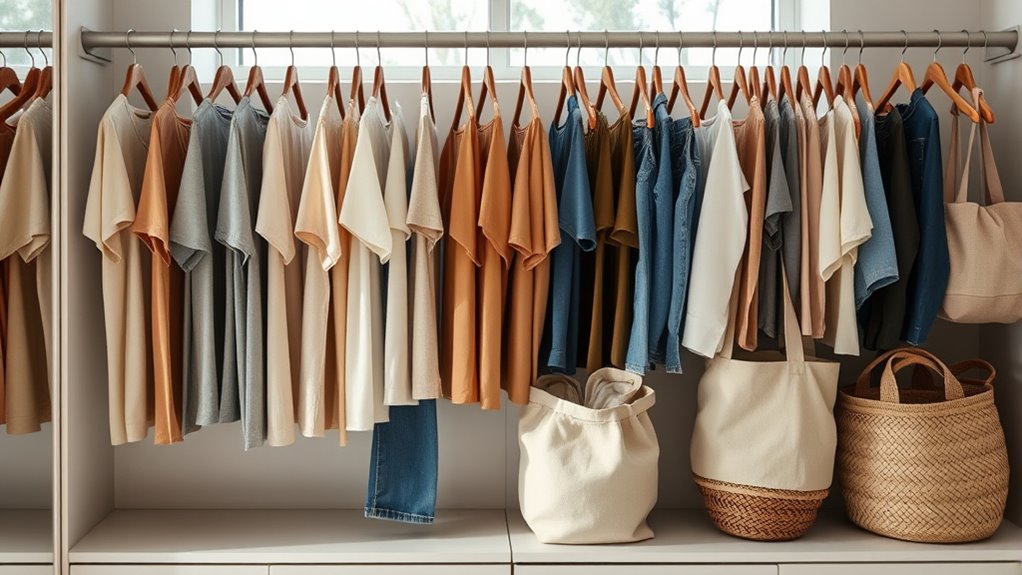To reduce fashion waste, regularly assess and curate your wardrobe by keeping only pieces that fit your style and serve a purpose. Choose quality, timeless items over fast fashion, and take good care of your clothes through proper washing and maintenance. Repair or upcycle old garments to extend their life, and support sustainable brands that prioritize eco-friendly materials. Recycling or donating unused items also helps. Keep exploring ways to build a mindful wardrobe and minimize waste.
Key Takeaways
- Regularly assess and declutter your wardrobe to identify gaps and eliminate unused or worn-out items.
- Focus on investing in timeless, versatile, and high-quality pieces that can be mixed and matched for multiple outfits.
- Practice proper garment care, including washing gently, repairing damages, and upcycling old clothes into new accessories or items.
- Support sustainable and ethical fashion brands that prioritize eco-friendly materials and fair labor practices.
- Dispose of clothes responsibly by donating, selling, or recycling textiles to promote a circular fashion economy.
Assess and Curate Your Wardrobe Regularly
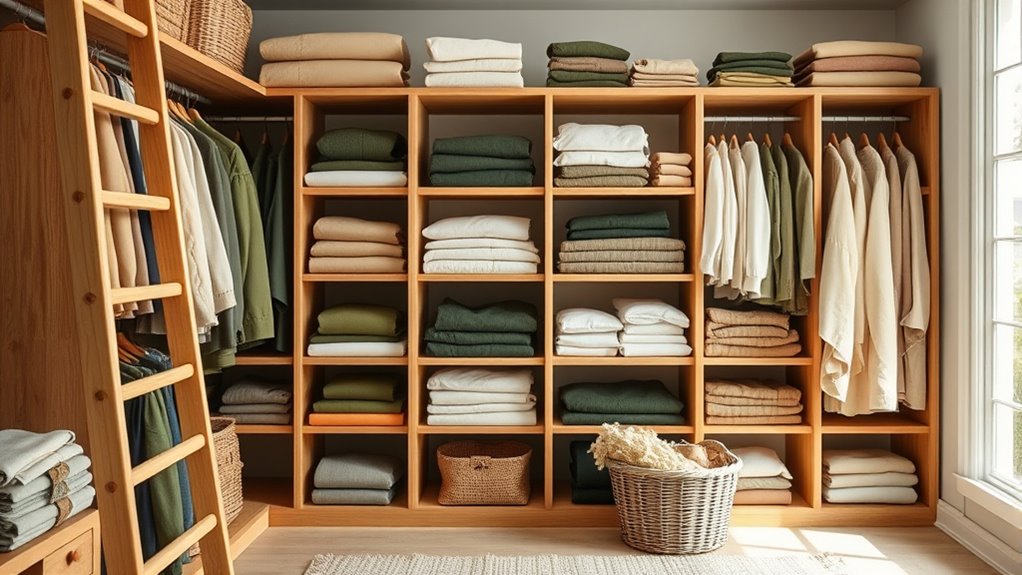
How often do you appraise what’s in your wardrobe? Regularly assessing your clothing helps you understand what you truly wear and need. Take time to go through your wardrobe at least once every few months. Remove items that no longer fit, suit your style, or get worn out. Be honest about pieces you haven’t touched in a long time; chances are, you won’t miss them. Keep only the clothes that make you feel good and serve a purpose. Use this process to identify gaps or excess. Curating your wardrobe keeps it manageable and reduces clutter. Plus, it encourages mindful shopping, so you’re less likely to buy unnecessary items. Regular evaluation is key to maintaining a sustainable, waste-free wardrobe. Incorporating clothing storage tips can inspire sustainable transportation choices and reduce environmental impact. Additionally, practicing data-driven strategies in your wardrobe management allows you to track and optimize your clothing habits for better sustainability. Understanding juice detox benefits can help inform healthier lifestyle choices that support your overall well-being and sustainable living. A thoughtful approach to your wardrobe also aligns with celebrity lifestyle insights, helping you adopt more sustainable and stylish habits.
Choose Quality Over Quantity
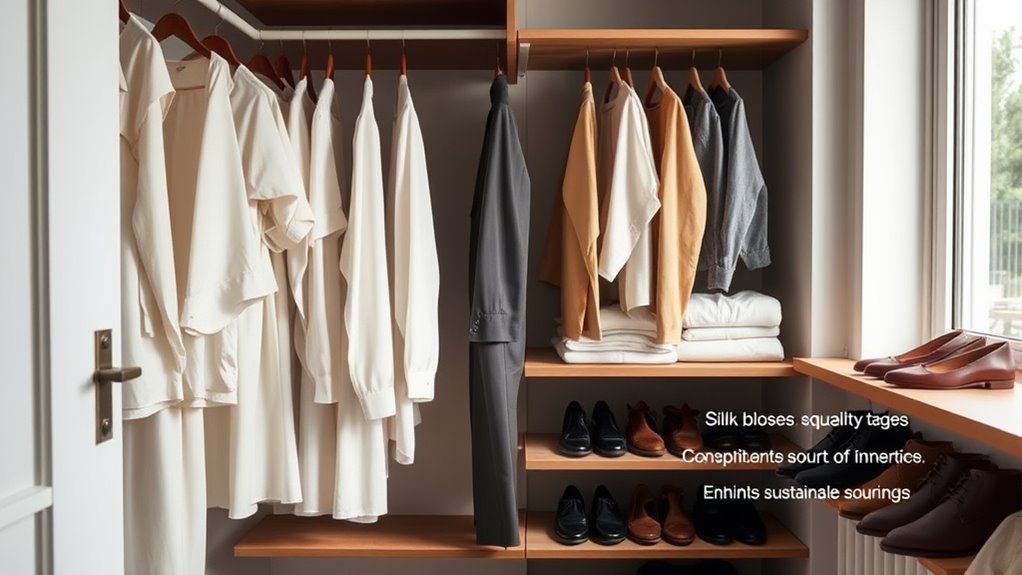
Opting for quality over quantity is one of the most effective ways to reduce fashion waste. When you invest in well-made pieces, you’ll find they last longer and withstand frequent wear. High-quality clothes often use better materials and construction, meaning fewer replacements and less landfill waste. Before buying, consider the durability, fabric, and craftsmanship of an item. Focus on versatile styles that can be paired with multiple outfits, ensuring you get more use out of each piece. Although quality items might cost more upfront, they save you money over time and reduce the need for constant shopping. By choosing quality, you make more sustainable choices and help decrease the fast fashion cycle that contributes heavily to environmental waste. Additionally, selecting durable clothing helps extend the lifespan of your wardrobe and minimizes waste generated from discarded garments. Incorporating ethical manufacturing practices into your purchasing decisions can further enhance the sustainability of your wardrobe. Being mindful of environmentally friendly dyes and production methods also supports eco-conscious fashion choices. Moreover, considering care and maintenance can help preserve the quality of your clothing longer, reducing waste. Furthermore, opting for sustainable fabrics such as organic cotton or recycled materials can significantly lessen your fashion footprint.
Embrace Versatile and Timeless Pieces
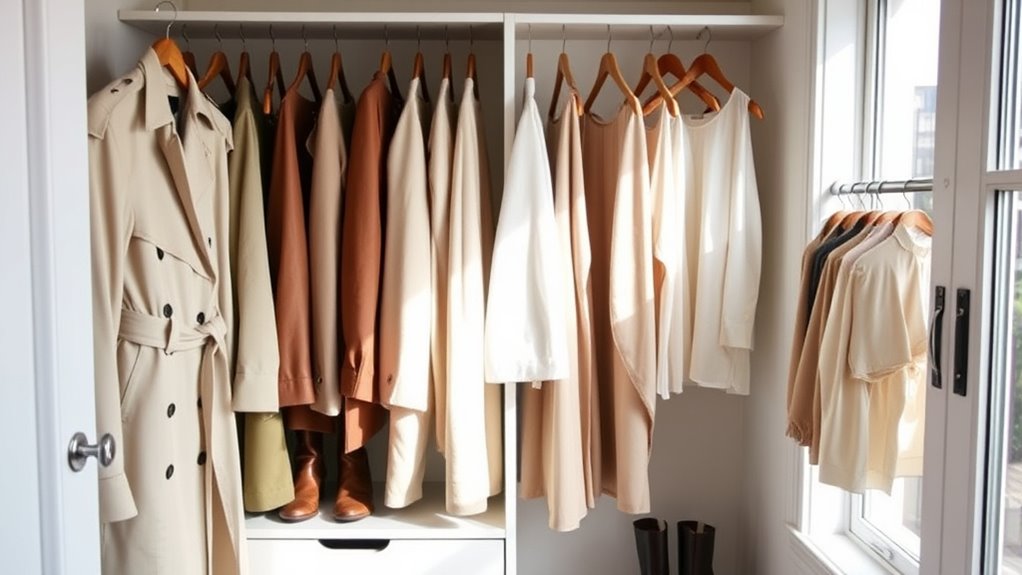
You can reduce waste by investing in classic, versatile pieces that never go out of style. Mixing and matching these items allows you to create numerous outfits without constantly buying new ones. This approach helps you build a sustainable wardrobe that lasts. Incorporating timeless fashion can further promote longevity and reduce the frequency of purchases, reinforcing your commitment to sustainability. Additionally, selecting multi-functional furniture can further optimize your space and reduce the need for additional purchases, enhancing your eco-friendly lifestyle. Regular use of exfoliation products like glycolic acid can also improve skin texture and radiance, supporting a more confident and sustainable self-care routine.
Invest in Classics
Investing in classic wardrobe staples is one of the most effective ways to reduce fashion waste. These timeless pieces stay stylish over years, reducing the need for constant replacements. To build a sustainable wardrobe, focus on:
- Quality over quantity – Choose well-made items that last longer and withstand trends.
- Neutral colors – Pick versatile shades like black, white, or navy that match easily and elevate any outfit.
- Simple designs – Opt for clean-cut styles that won’t go out of fashion quickly and work for various occasions.
Mix and Match
Building a wardrobe with versatile and timeless pieces allows you to create countless outfits with fewer items. By mixing and matching these essentials, you maximize your wardrobe’s potential and reduce waste. Focus on neutral colors and classic styles that pair well together, making wardrobe decisions easier. For example, a white shirt, dark jeans, and a blazer can be combined in different ways for work, casual outings, or evenings out. To visualize, consider this:
| Piece | Style Tip | Occasion |
|---|---|---|
| White shirt | Layer with scarves or jackets | Formal or casual |
| Dark jeans | Add accessories or tops | Day or night |
| Blazer | Pair with different bottoms | Business or casual |
Mixing these creates fresh looks without buying more. Incorporating timeless styles ensures your wardrobe remains relevant and sustainable over the years. Additionally, choosing pieces made from sustainable materials can further reduce your environmental impact and support eco-friendly fashion choices. Practicing mindful shopping habits also plays a crucial role in maintaining a zero-waste wardrobe over time. Understanding the importance of color coordination can help you build more outfit combinations efficiently and reduce unnecessary shopping. Developing a capsule wardrobe can also streamline your closet and minimize excess purchases.
Practice Proper Garment Care to Extend Lifespan

Practicing proper garment care is essential for extending the lifespan of your clothes and reducing waste. When you take good care of your wardrobe, you prevent unnecessary damage and keep items looking new longer. Here are three simple steps to help you do that:
- Wash clothes less frequently and only when necessary, using cold water to save energy and prevent wear.
- Follow care labels carefully, avoiding harsh detergents and high heat settings that can weaken fabrics.
- Store clothes properly—fold or hang them neatly to prevent stretching and fading.
- Utilizing AI-driven data analytics can help identify the best garment care practices tailored to different fabric types, further prolonging clothing life and reducing clothing waste. Incorporating sustainable fashion practices can also minimize environmental impact and promote eco-friendly wardrobe management, especially when combined with proper clothing maintenance techniques. Additionally, understanding fabric care can help you choose the most suitable cleaning methods for each material, ensuring longevity.
Repair and Upcycle Old Clothing

When your clothes get damaged, sewing repairs quickly can save them from ending up in the trash. Get creative by transforming old pieces into new styles or unique accessories. Don’t forget to use fabric remnants to add details or make small projects—every scrap counts. Incorporating upcycling techniques can further extend the life of your wardrobe and reduce waste. Additionally, exploring climate control strategies like proper insulation and maintenance can help preserve your clothing, ensuring your wardrobe remains functional and sustainable over time. Using durable materials in your repairs can also enhance longevity and withstand environmental factors. For instance, selecting professional-quality dyes can help maintain color vibrancy and minimize the need for frequent re-dyeing or replacement.
Sew Repairs Quickly
Repairing and upcycling old clothing is a practical way to extend the life of your wardrobe and reduce waste. When you sew repairs quickly, you prevent garments from ending up in the trash. Focus on these key steps:
- Identify small tears or loose seams immediately, so they don’t worsen.
- Use a needle and thread matching the fabric to make discreet, durable repairs.
- Keep a sewing kit handy for quick fixes, like replacing buttons or patching holes.
- Educating yourself about sustainable fashion practices can further help minimize your wardrobe’s environmental impact.
Transform With Creativity
Once you’ve made quick repairs, you can take your old clothing a step further by transforming it into something new and unique. Upcycling allows you to reuse fabric creatively, giving your wardrobe a personal touch. You might turn an outdated shirt into a trendy tote bag or add embellishments to refresh a plain dress. Experiment with cutting, sewing, or dyeing to create entirely different pieces. This process not only extends the life of your clothes but also reduces waste and saves money. Embrace imperfections and see them as opportunities for originality. By reimagining what you already own, you foster sustainability and express your style. Upcycling transforms simple repairs into artistic statements, making your wardrobe more eco-friendly and uniquely yours.
Use Fabric Remnants
Using fabric remnants is a practical and creative way to breathe new life into your old clothes. Instead of tossing worn or outdated pieces, consider upcycling with leftover fabrics. Here’s how:
- Repair: Fix small tears or holes with patches made from remnants, extending your garment’s lifespan.
- Add Details: Sew decorative trims, pockets, or appliqués to refresh dull clothing and personalize your style.
- Create New Items: Combine remnants to craft accessories like headbands, scrunchies, or small bags, reducing waste and expanding your wardrobe sustainably.
Opt for Sustainable and Ethical Brands
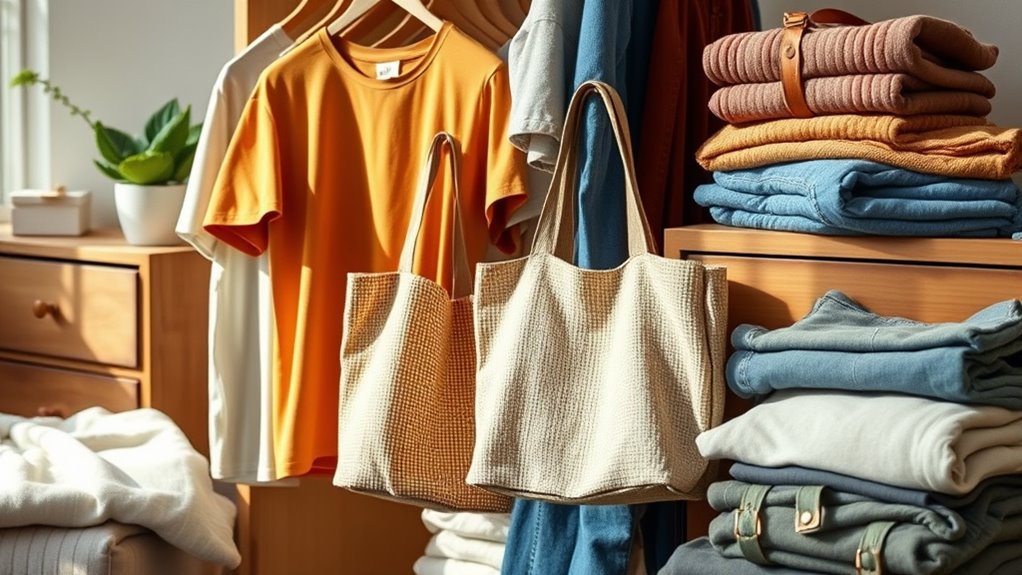
Choosing sustainable and ethical brands can substantially reduce your fashion waste because these companies prioritize environmentally friendly materials and fair labor practices. When you shop from such brands, you’re supporting processes that use organic fabrics, recycled materials, and less water and energy. These brands often produce durable clothing meant to last, so you’re less likely to discard items quickly. By choosing ethically made fashion, you help reduce waste generated from fast fashion’s short-lived trends and mass production. It’s also a way to ensure fair wages and safe working conditions for laborers. When you make conscious choices about the brands you support, you contribute to a more sustainable fashion industry and minimize your environmental footprint. This shift encourages manufacturers to adopt greener, more responsible practices.
Donate or Sell Unwanted Items Responsibly
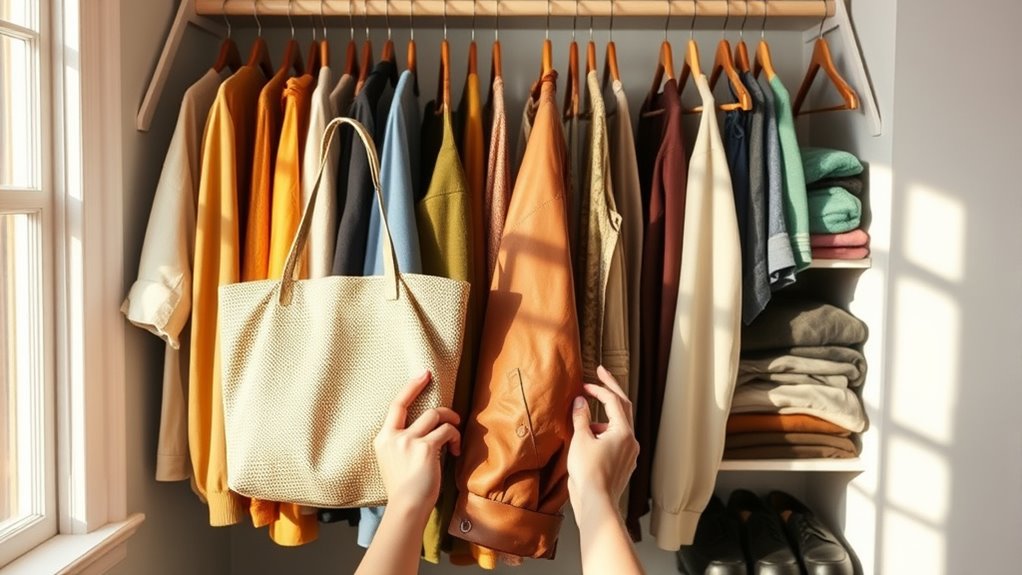
After supporting sustainable brands, you can further reduce fashion waste by responsibly donating or selling your unwanted clothing. First, evaluate the condition of your items—if they’re still in good shape, consider donating to charities or shelters. Second, explore online platforms or local consignment shops to sell clothing that’s trendy or in demand. Third, avoid dumping clothes in regular trash; instead, choose responsible disposal options like textile recycling programs. By doing so, you extend the life of your garments and prevent unnecessary waste. Remember, quality and proper handling matter—ensure clothes are clean and intact. This approach helps keep fashion waste out of landfills and supports a circular fashion economy. Your mindful choices make a real difference.
Incorporate Clothing Swaps and Sharing
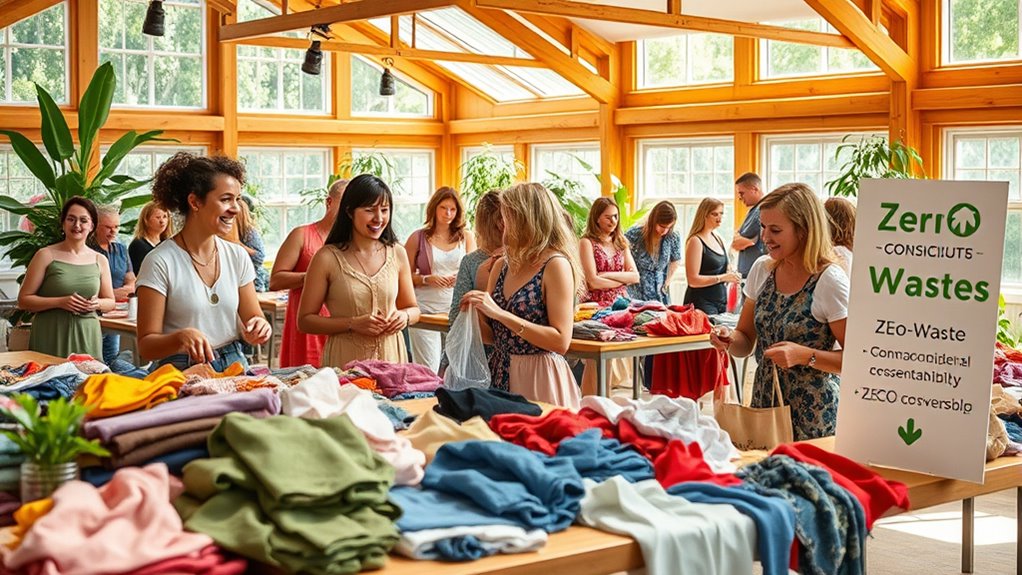
Clothing swaps and sharing are effective ways to extend the life of your wardrobe and reduce waste. By swapping clothes with friends or participating in community swap events, you give your items a new home instead of sending them to landfill. Sharing clothing through rental services or online platforms allows you to enjoy new styles without buying new pieces. These practices promote a circular fashion mindset, helping you access a variety of clothes while minimizing waste. Plus, they foster social connections and encourage mindful consumption. To get started, organize a swap party with friends or explore local and online sharing options. Remember, the goal is to maximize the value of what you already own and keep garments circulating longer.
Educate Yourself on Sustainable Fashion Practices
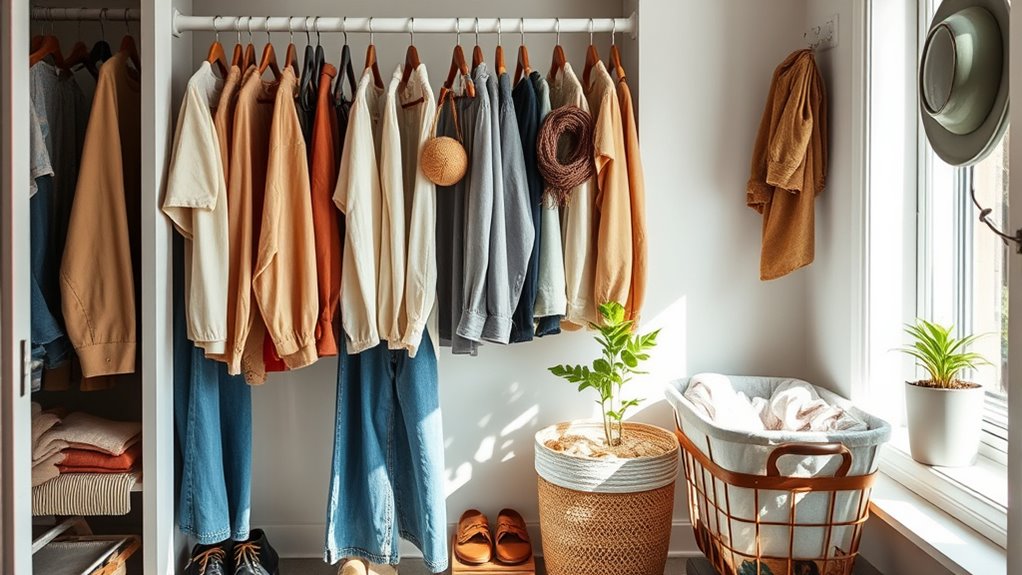
Learning about sustainable fashion practices empowers you to make informed choices that reduce environmental impact. Start by researching brands committed to ethical production, ensuring they prioritize fair labor and eco-friendly materials. Next, learn about fabric types: choose natural fibers like organic cotton or hemp over synthetic ones that shed microplastics. Finally, stay updated on industry innovations, such as recycling programs or zero-waste design techniques. These steps help you identify truly sustainable options and avoid greenwashing. By educating yourself, you gain the knowledge to support responsible brands and make mindful purchases. Over time, this awareness encourages a shift towards a zero-waste wardrobe, reducing waste and lowering your fashion footprint. Knowledge truly is power in creating a more sustainable, stylish wardrobe.
Frequently Asked Questions
How Can I Identify Truly Sustainable Fashion Brands?
When you’re trying to spot truly sustainable fashion brands, look for transparency. Check if they share details about their sourcing, manufacturing practices, and labor conditions. Look for certifications like Fair Trade or GOTS, which indicate eco-friendly and ethical standards. Research their materials—preferably organic, recycled, or low-impact. Supporting brands with a clear commitment to reducing environmental harm helps you make more sustainable choices and encourages industry-wide change.
What Are the Best Ways to Store Clothing to Prevent Damage?
Imagine giving your wardrobe a gentle hug—that’s how proper storage protects your clothes. You should fold or hang items carefully, using padded hangers for delicate fabrics. Keep everything in a cool, dry spot away from sunlight, which can fade colors. Use breathable garment bags for extra protection, and avoid overcrowding to prevent wrinkles and damage. With these simple steps, your clothes stay fresh, vibrant, and ready for wear.
How Do I Determine if Clothing Is Ethically Made?
To determine if your clothing is ethically made, start by researching the brand’s transparency and labor practices. Look for certifications like Fair Trade or GOTS, which indicate ethical standards. Check the company’s website for info on sourcing and worker conditions. You can also read reviews and reports from watchdog organizations. When you buy, choose brands committed to fair wages, safe working environments, and sustainable materials to support ethical fashion.
Can Secondhand Shopping Be More Affordable Than Buying New?
Imagine finding a hidden treasure in a thrift store—secondhand shopping often costs less than buying new. Studies show you can save up to 50% or more when you choose used clothing. You get quality pieces at a fraction of the price, making it more affordable than new. Plus, you’re helping the environment by reducing waste. So, yes, secondhand shopping can definitely be more budget-friendly than buying brand new.
What Are Eco-Friendly Alternatives to Traditional Dry Cleaning?
You’re wondering about eco-friendly alternatives to traditional dry cleaning. Instead of chemical-heavy processes, try using microfiber or reusable cloths with natural cleaning solutions like vinegar or baking soda for spot cleaning. You can also explore professional green dry cleaners that use biodegradable solvents and energy-efficient methods. In addition, washing delicate garments at home on gentle cycles and air-drying helps reduce your environmental impact and keeps your wardrobe eco-friendly.
Conclusion
Just like the heroes of old who fought to preserve their worlds, you can champion sustainability by building a wardrobe that lasts. Regularly assess, choose quality, and embrace timeless pieces. Repair, upcycle, and share your clothes responsibly. Remember, each small step echoes the enduring wisdom of sustainability’s heroes—your choices today shape a greener tomorrow. Take action now, and let your wardrobe be a demonstration to the heroism of mindful fashion.
